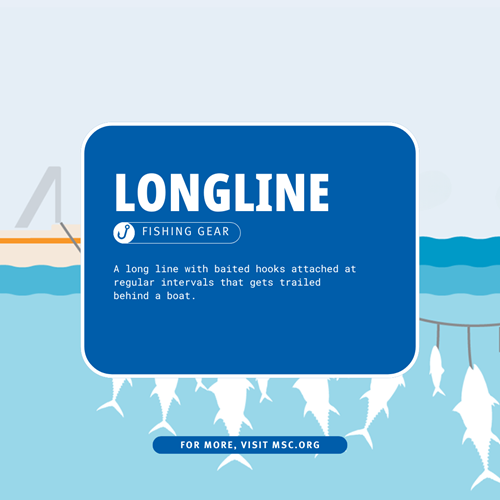What is longline fishing?
Longline fishing uses a long line of baited hooks to catch fish. Longlines can be set for surface, midwater, or demersal (sea floor) fishing depending on the target species.
Pelagic longlines
The term pelagic refers to use of longlines in the water column of the open ocean. Pelagic longlines are set near the surface, or between depths of ~160-1,000 feet, with floats or buoys that are spaced along the length of the line to maintain its depth. Lines can be left in the water for differing periods, but usually not longer than half a day.The lines themselves can be ~30-60 miles long with many hundreds, or even thousands, of baited hooks attached to shorter lines (called ‘gangions’), which are hung at intervals along the main line. The length of and distance between gangions depends on the target species.
/rs5077_longline-content.png?sfvrsn=2ce75fde_6)
Which species are caught by longline fishing?
The type of hook used and the position of the lines in the water column help determine the species caught.Pelagic longlines are primarily used to catch species that swim in the midwater or surface zones such as tuna (e.g., bluefin, yellowfin, albacore) and swordfish.
Demersal longlines are used mainly to fish for deep water and bottom dwelling species such as halibut, cod, hake, and Patagonian toothfish (Chilean sea bass).
What are the environmental impacts of longline fishing?
All types of fishing gear can have an impact on the ocean environment and can have significant environmental impacts, if not sustainably managed.Longlines can be associated with high bycatch: non-target species that are caught by the baited hooks. Pelagic longline bycatch can include sea turtles, sharks, rays, seabirds, marine mammals, and other Endangered, Threatened and Protected (ETP) species.
How can longline fishing reduce bycatch?
All MSC certified fisheries must demonstrate their fishing operations and gear have low impacts on the environment.
To be certified as sustainable against the MSC Fisheries Standard, fisheries are often required to make improvements to their monitoring programs, and to mitigate interactions with non-target species. This can be done through improved understanding of bycatch species in terms of where and when they are most at risk of being accidentally caught.
Handling and data collection
Sustainable pelagic longline fisheries train their crew in handle-and-release techniques, designed to release bycatch alive. Fishers can tag bycatch prior to release, helping them acquire data on the species involved. This data can provide more information on the species’ life histories, post-release survival rates, migratory routes, and breeding grounds. This can help fisheries avoid fishing at times and locations that are important to the species’ survival.
Data can also be acquired by independent scientific observers, who log and report fishery interactions with bycatch species.
Reduction devices
Bycatch reduction devices, such as “tori-lines” – streamers that form visual barriers around the longline -are also used by sustainable fisheries. Tori-lines prevent seabirds from accessing the baited hooks as the longline is deployed, reducing the likelihood of the birds becoming entangled.
Modifications to gear itself may also be used to improve outcomes for potential bycatch species. Modified gear can include the use of circle hooks that reduce the likelihood of hooking non-target species and hook in the corner of the mouth, aiding release. The weighting of longlines to make them sink more quickly can also reduce interactions with seabirds at the surface. Not using wire trace lines reduces the number of sharks that are caught.
How can longline fishing help to end overfishing?
As well as minimizing bycatch, data acquired at-sea from MSC certified fisheries is used to inform fishing practices and track catches. The data provides valuable information on the target stock’s population numbers and the interactions with non-target species. This may be used to inform the fisheries’ harvest control rules and strategies and to set catch limits, ensuring stocks are not overfished.




